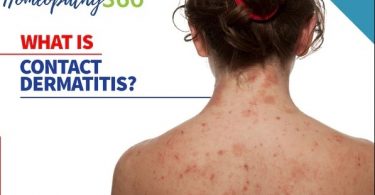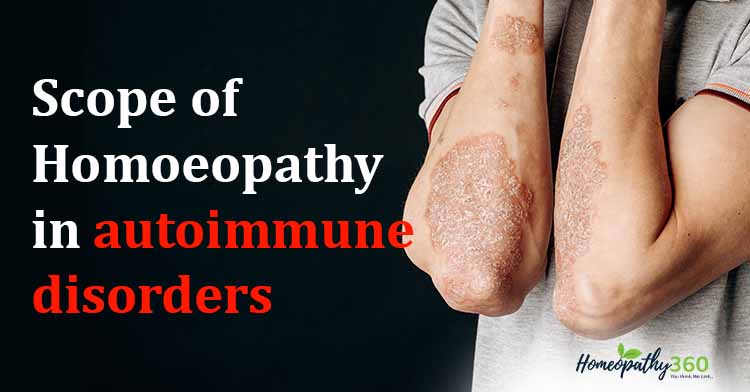
ABSTRACT
Introduction : Psoriasis is a common, chronic, inflammatory skin disease with a spectrum of clinical attribute which results from the interplay of genetic, environmental, and immunological constituent. Many decades of clinical and basic research on psoriasis have explained many of the pathogenic mechanisms underlying disease and have covered the way to effective targeted therapies. Here, review of this case study shows progress and identify future directions of homeopathic treatment of autoimmune skin diseases that are supported by a more integrative research approach and aim at further improving the patients’ life.
A 60-years-old man was brought for homoeopathic treatment of psoriatic skin lesion in multiple part of body with the hope to avoid steroidal application as well as any excess medicinal intervention. After full case taking, case analysis and proper individualisation, a single homoeopathic medicine was prescribed. After 6 months of the treatment, the patientwas relieved of his presenting symptoms which gave disappearance of all skin lesions and general improvement of his health followed by no further reappearance of skin lesions for next 2.5 years.
Conclusion: This article provides a clinically useful review of a case with evidence about how an individualised homoeopathic medicine treated an autoimmune skin disorder successfully. It also provides a reference for clinicians treating cases of psoriasis.
KEYWORDS
Psoriasis, autoimmune disease, homoeopathy, case report
INTRODUCTION
Psoriasis is a chronic proliferative and inflammatory condition of the skin.[1]It is usually characterized by erythematous plaques covered with silvery scales, particularly over the extensor surfaces, scalp, and lumbosacral region.[2] Joints and eyes are also seen to be affected on this disorder.The eye is involved in about 10% of patients, mostly women.In general, the eye is rarely involved alone; it is almost always associated with skin features.[2]Among several subtypes of psoriasis,the plaque type is the most common and presents on the trunk, extremities, and scalp.Close examination of the plaques usually reveals white silvery scales. Psoriasis has no cure and the disease ebbs and flows with flareups.Many patients with psoriasis can develop depression as they lead a poor quality of life.[1] Clinical manifestation of skin lesions was provisionally diagnosed as psoriasis by physician and was confirmed by Grattage test which gave a positive auspitz sign.It has been seen repeatedly in clinical cases that if homoeopathic medicines have been selected and given by following homoeopathic principles, psoriasis can be treated fairly successfully. In the below described case, it is clear that individualised simillimum remedy can enable a fairly quick recovery.
CASE PRESENTATION
Patient information
A 60-year-old man, fair complexion, moderate build.
Case history
Patient presented with reddish patchy skin eruption on nape of neck,both leg(lateral tibial side) and over the both elbow region since 3 month. He has experienced with repeated episodes of similar suffering 1 year ago for two times.The patient applied steroidal ointments as medication.The patient appeared to have a good hygiene level. Based on his daughter’s narration, the patient was very impatient in nature, felt restless until his assigned task was done.He liked to stay very taintless, in organised manner at home and also desired for company.The patient had craving for cold drinks with large thirst but take only a little water at a time.
Clinical findings with confirmed diagnosis:
Grattage test was done which gave a positive auspitz sign.So it is a case of Psoriasis.
Differential diagnosis:[2]
| Background | Vessel types | Vessel arrangement | Scales | Additional features | |
| Psoriasis | Reddish-pinkish Whitish (due to hyperkeratotic scales) | Dotted | Regular | Whitish-grayish | |
| Dermatitis | Skin coloured-pinkish | Dotted | Scattered/patchy | Yellowish | Irregularly distributed dot blood haemorrhages due to traumatisation |
| Tinea corporis | Reddish | Dotted | Peripheral | White and rough; peripheral; moth-eaten pattern; tend to peel outwards | |
| Pityriasis rubra pilaris | Dark red/yellowish red | Linear and/or dotted | Scattered | Yellowish-whitish; follicular | Perifollicular yellow-orange halos, follicular plugs, central hair |
| Squamous cell carcinoma in situ | Pinkish | Glomerular or dotted | Regularly in center, may organize in lines at the periphery | Yellowish white scales | Peripheral actinic keratosis areas may help (white and wide follicular openings, rosettes) |
Physician’s observation:
The patient was restless, anxious while communicating with physician and was repeatedly expressing fear about the future of his son.
Analysis and evaluation of symptoms
| Mental generals | Physical generals | Particulars |
| 1.Restless. 2. Impatient. 3. Desire for company. 4. Anxiety about future. 5.Anxious. 6.Fastidious. | 1.Chilly patient. 2.Craving cold drinks. | 1.Reddish scaly eruption 2.Repeated eruptions. |
Totality of symptoms
1.Impatient.
2.Restless.
3.Desire for company.
4.Fearful about future.
5. Anxious.
6. Fastidious.
7.Profuse thirst.
8.Chilly patient.
9.Craving for cold drinks.
10.Reddish scaly eruptions.
11.Gastric trouble occasionally.
12.Disturbed sleep.
Miasmatic analysis
The mental and physical characteristic symptoms indicates that the sycotic and psoric miasms are dominant. [4]
Repertorisation (Hompath Zomeo)
As the case presented with prominent mental and physical general symptoms, the Kent repertory was selected for repertorisation with the help of Hompath Zomeo.[5]
(Fig. 1)
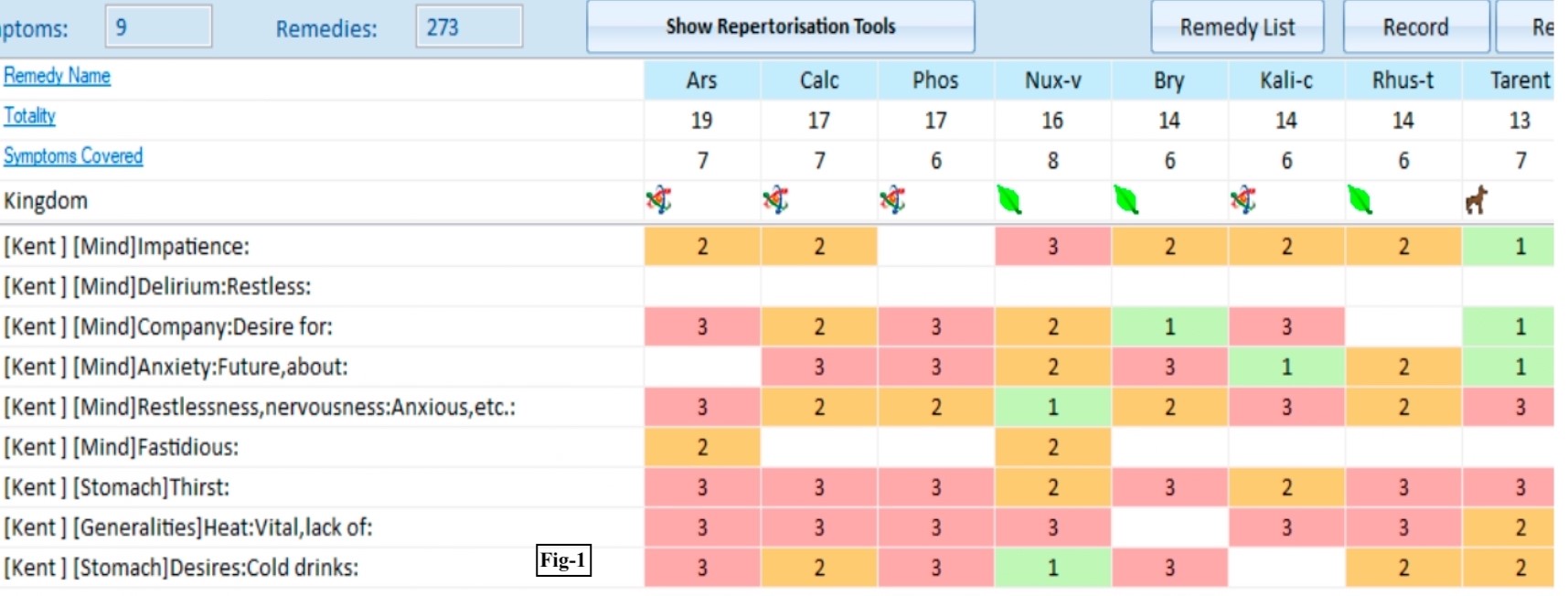
Therapeutic intervention
Treatment plan
- Individualised homoeopathic medicine with proper dose and potency by following homoeopathic laws and principles.[6,7,8]
Prescription
Repertorisation was done considering the mental generals and the uncommon, peculiar symptoms, all of which indicate the remedy Arsenicum album.
Differentiation of top three indicating remedy from repertorisation
Though top three medicines were well indicating for the case but the highest ranking remedy got selected because of it’s most similarity with the individual patient with peculiar mental characteristic.Symptoms like desire for company, anxiety about the future, nervousness, restlessness are well covered by Calcarea carbonicum and Phosphorus remedy also but finally mental symptom fastidious takes charge over these two remedy by Arsenicum albumremedy so here final selection of the remedy is ARSENICUM ALBUM.
Follow-up and Outcomes
Follow-up criteria:-
1. Changes in skin lesion.
2. Recurrence of the complaints.
3. Improvement in physical and mental health indicators: appetite, stool, thirst, and sleep.
| Date | Symptoms | Prescription |
| 11/12/2019 | Chief complaints(Fig-2a,3a,4a,5a) | Arsenicum album 30 Single dose |
| 09/01/2020 | Improvement started. Redness of skin lesion reduced. | Rubrum metallicum 30 for next 1 month |
| 11/02/2020 | Redness and scaling of skin lesion improved. | Rubrum metallicum 30 for next 1 month |
| 10/03/2020 | Further improvement seen. | Rubrum metallicum 30 for next 1 month |
| 11/04/2020 | Little lesion remained. | Rubrum metallicum 30 for next 1 month |
| 14/05/2020 | Complete disappearance of scaly skin lesion.only dark spot remained in some area as healing sign.(Fig-2b,3b,4b,5b) | Rubrum metallicum 30 for next 6 months. Advised to report if complaints return. |
| 30/12/2020 | 1) No recurrence of the complaints; further improvement of patient. 2)Sleeps well now. 3) He was passing normal stool almost regularly. 4) Appetite, thirst, sleep, and all other generalities improved. 5) Normal appearance of skin(Fig. 3) 6) The patient’s restlessness and anxiety had reduced according to his daughter. | No medicine; advised to report immediately if complaint returns. He was also advised to visit the physician at every 3 month interval so that any reappearance of the complaints can be noted down. |
| 28/03/2021 | No recurrence of the complaints; further improvement of patient. | No medicine |
| 30/06/2021 | No recurrence of the complaints; further improvement of patient. | No medicine |
| 27/09/2021 | No recurrence of the complaints; further improvement of patient. | No medicine |
| 31/12/2021 | No recurrence of the complaints; further improvement of patient. | No medicine |
| 15/06/22 | No recurrence of the complaints after 2.5 years of treatment.. | Patient was considered as cured but advised to contact the physician if he faces any further complaint |
BEFORE AND AFTER TREATMENT PICTURE OF THE PATIENT:
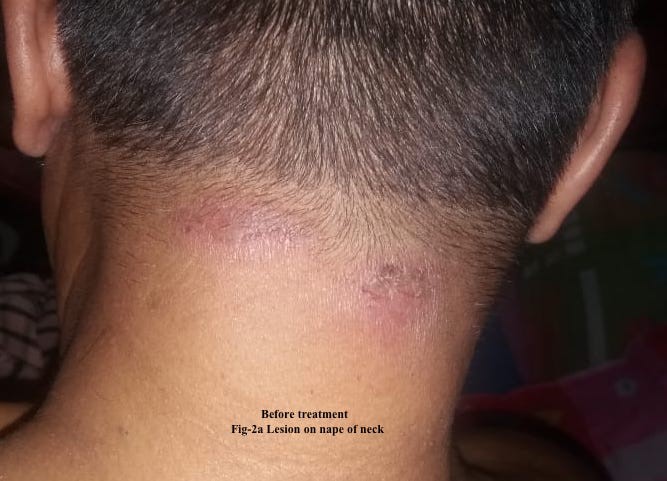
Fig-2a Lesions on nape of neck(Present)
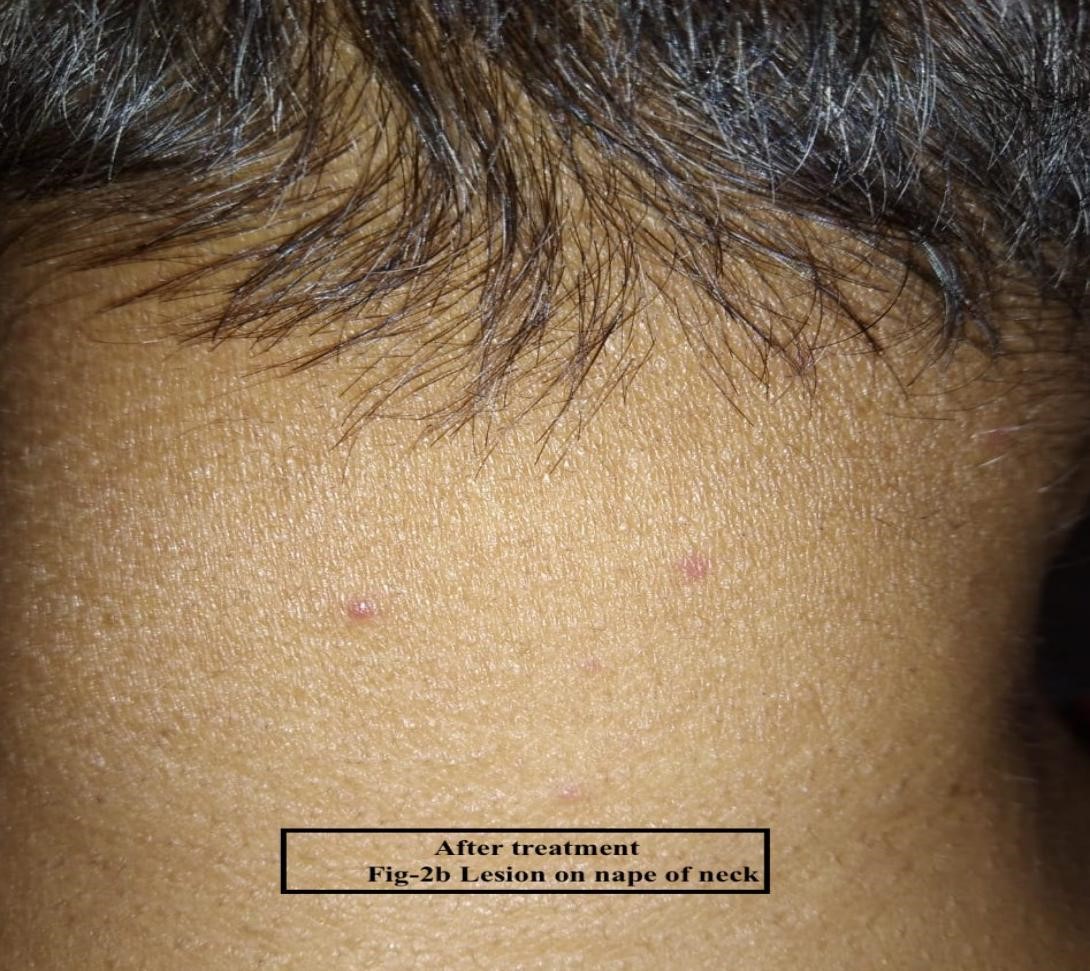
Fig-2b
Lesions on nape of neck(Disappeared)
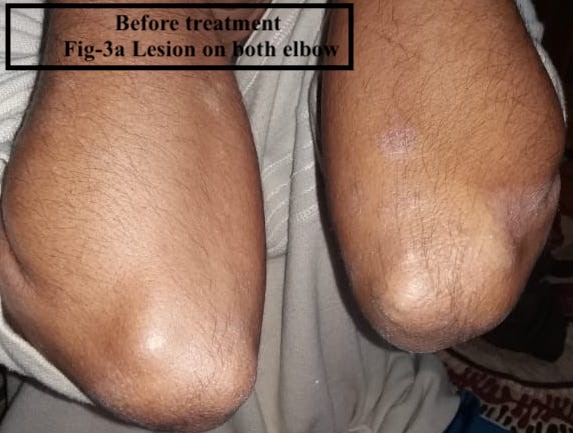
Fig-3a Lesions on both elbow (Present)
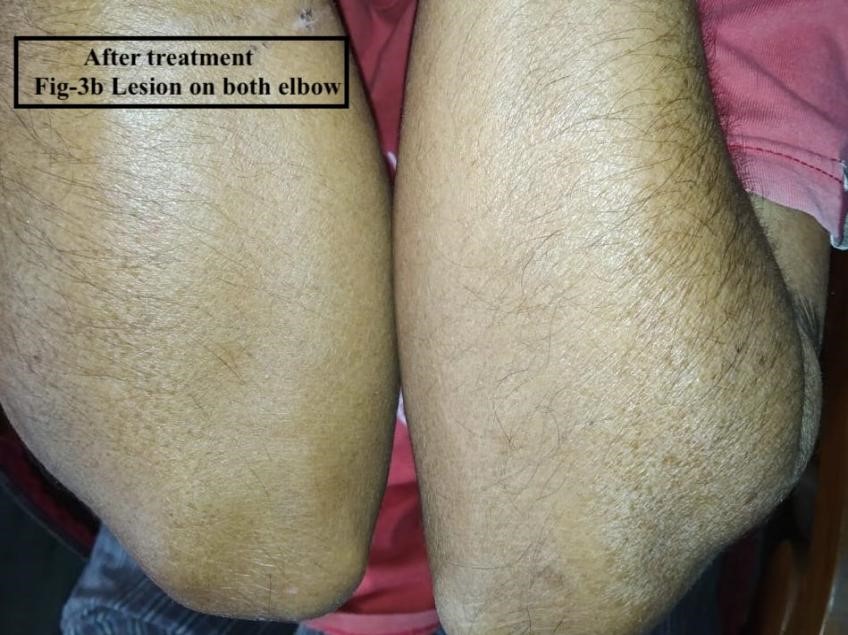
Fig-3b Lesions on both elbow(Disappeared)
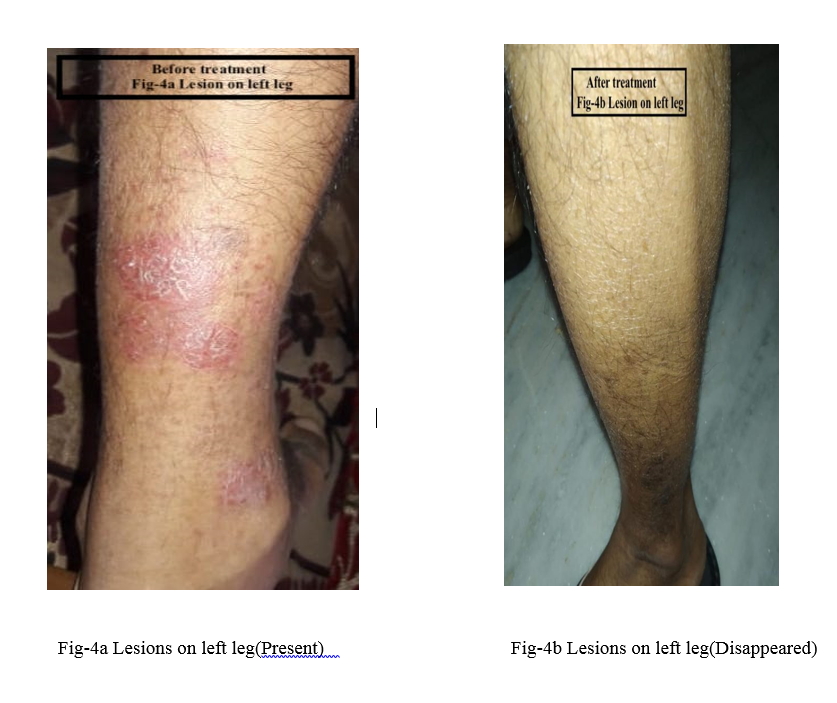

DISCUSSION
Why individualisation is the option of choice?
It is described in §153 of organon of medicine, that it is the most striking, singular, uncommon, peculiar, or characteristic symptoms of the disease that are to be kept chiefly and most solely in view; it is for analogues to these that we must search through the lists of medicinal symptoms[6].
For this particular case, some very striking characteristic symptoms of the patient could be co-related with the medicinal symptoms of Arsenicum albumlike fastidiousness, restlessness, impatient, anxious and fearful about future, chilly patient, profuse thirst.
The homoeopathic dose must be given in a dose so small that it would not produce a severe aggravation of the already existing symptoms.[8] The success of homoeopathic treatment depends to a great extent on the correct selection of the potency and the requisite potency should be selected through the susceptibility of the patient. [9,10] In this particular case, the most similar homoeopathic medicine was prescribed, i.e., Arsenicum album30. The remedy was selected through individualisation of the case through proper evaluation and analysis of the symptom totality. A single dose was administered, as the law of similia and law of minimum dose were followed.
Autoimmune disease and role of homoeopathy
In medical science, it does not have any specific cause why it occurs. But there are certain factors that may responsible for developing autoimmune diseases.[1]In this regard, homeopathy has a prospective role of treatment in the autoimmune disease as because homoeopathic treatment is not only based on the disease symptoms alone but the person’s psychological and emotional symptoms are also taken care of. [8] Every individual has its own trigger factors either in his psychological level or emotional level or physical level or genetic level. Homeopathy treatment finds the thread of root cause of the triggers factors and treat accordingly, thus helps to bring back the equilibrium of the body’s immune system in a natural way to normal state thus may help to cure the autoimmune diseases.[9]
CONCLUSION:
The treatment of psoriasis in modern medicine is very limited and provides very short term relief with some side effect.This case report suggested that Homoeopathy can be used as effective therapy for the management of chronic psoriasis.
CONFLICT OF INTEREST: None.
CONSENT OF THE PATIENT:Taken from Patient with signature for the purpose of sharing pictures.
ACKNOWLEDGEMENT: The Calcutta Homeopathic Medical College and Hospital.
REFERENCES
- Ralston SH, Penman ID, Strachan MWJ, Hobson R. Davidson’s principles and practice of medicine (23rd ed.). Elsevier Health Sciences.
- Kasper DL, Fauci AS, Hauser S, et al, editors. Harrison’s principles of internal medicine, 19th ed. [monograph on the Internet]. New York: The McGraw-Hill Companies.
- Hahnemann S. The Chronic diseases, Their Peculiar Nature and Their Homoeopathic Cure. New Delhi: B. Jain Publishers (p) Ltd; 2016.
- Palamar D, Er G, Terlemez R, Ustun I, Can G, Saridogan M. Disease activity, handgrip strengths, and hand dexterity in patients with rheumatoid arthritis. Clin Rheumatol 2017;36:2201–2208.
- Hompath Zomeo – homeopathy software [Internet]. Hompath.com.
- Ganguly SN. Annotated Text of Hahnemann’s Organon of Medicine. 5th ed. Shahdara: Birla Publications Pvt. Ltd; 2007.
- Close S. The Genius of Homoeopathy. New Delhi: B. Jain publishers (P) Ltd; 2004.
- Dudgeon RE. Lectures on the Theory and Practice of Homeopathy. New Delhi: B. Jain publishers (P) Ltd.
- Dey SP. Essentials of principles and practice of homoeopathy. 4th ed. Kolkata: Published by Smt. A Bhattacharya; 2009.
- Kent JT. Lesser Writings. New Delhi: B. Jain publishers (P) Ltd; 2004.
ABOUT THE AUTHORS:
Dr Navin Kumar Singh : MD(Hom.) Lecturer of the department of Case Taking and Repertory,The Calcutta Homoeopathic Medical College and Hospital,Kolkata, WB.
Dr Tamara Afroza : MD,( Hom.) Part-II in Practice of Medicine from The Calcutta Homoeopathic Medical College and Hospital. B.H.M.S (Honours) from D.N.DE Homoeopathic Medical College and Hospital. Kolkata, WB.





